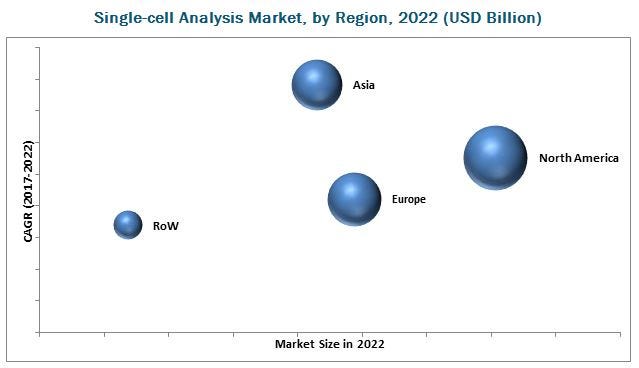The Growth of the Single-cell Analysis Market is mainly driven by the technological advancements in single-cell analysis products, increasing government funding for cell-based research, growing biotechnology and biopharmaceutical industries, wide applications of single-cell analysis in cancer research, a growing focus on personalized medicine, and increasing incidence and prevalence of chronic and infectious diseases.
The report “Single-cell Analysis Market by Product (Consumables and Instruments), Cell Type (Human and Animal), Technique (Flow Cytometry, NGS, PCR, and Mass Spectrometry), Application (Cancer, Neurology, NIPD, IVF, and CTCs), End User — Global Forecast”
The Single-cell Analysis Market is expected to reach the US $3.59 billion, at a CAGR of 16.5%.

Download PDF Brochure:
Based on the type of products, the Single-cell Analysis Market is segmented into consumables and instruments. the consumables segment is expected to dominate this market, primarily due to the requirement of frequent and repeat purchase of these products as compared to instruments, which are considered as a one-time investment.
Single-cell Analysis Market: The objectives for this study are as follows
- To define, describe, and forecast the market based on products, cell type, technique, application, end user, and region.
- To provide detailed information regarding the major factors influencing the growth of the market (drivers, restraints, opportunities, and industry-specific challenges)
- To strategically analyze micro-markets with respect to individual growth trends, prospects, and contributions to the market
- To analyze the opportunities in the Single-cell Analysis Market for stakeholders and provide details of the competitive landscape for market leaders
- To forecast the size of market segments with respect to four regions, namely, North America, Europe, Asia, and the Rest of the World (RoW)
Speak to our Subject Expert:
On the basis of technique, the Single-cell Analysis Market is segmented into flow cytometry, NGS, PCR, microscopy, mass spectrometry, and other techniques (including single-molecule fluorescence in situ hybridization, micromanipulation, and automated capillary electrophoresis). flow cytometry is expected to dominate the market. Wide usage of flow cytometry in single-cell analysis applications is expected to boost the demand for single-cell analysis techniques.
On the basis of the region, the Single-cell Analysis Market is segmented into North America, Europe, Asia, and RoW. North America accounted for the largest share of the market, followed by Europe. The large share of the North American Single-cell Analysis Market is attributed to factors such as increasing collaborations among prominent players, technological advancements and expanding biotechnology and pharmaceutical industries. Factors such as increased incidence of diseases, government support for various research activities, and growing focus on stem cell research and regenerative medicine are expected to fuel the market growth in the European region.
Request Free Sample Pages:
The Single-cell Analysis Market is highly competitive with the presence of major players. Merck KGaA (Germany), Becton, Dickinson and Company (U.S.), Promega Corporation (U.S.), Danaher Corporation (U.S.), General Electric Company (U.K.), Thermo Fisher Scientific Inc. (U.S.), Miltenyi Biotec (Germany), Illumina, Inc. (U.S.), Bio-Rad Laboratories, Inc. (U.S.), Fluidigm Corporation (U.S.), NanoString Technologies, Inc. (U.S.), Agilent Technologies (U.S.).
Thermo Fisher Scientific Inc. (U.S.) was the global leader in the Single-cell Analysis Market in 2015. It is a well-known company and has an exhaustive product portfolio. The company is innovation-centric and invests heavily in R&D for maintaining its market share. Moreover, the company focuses on inorganic growth strategies such as acquisitions for enhancing its market share. In February 2013, Thermo Fisher Scientific acquired Life Technologies, a leading player in the life sciences business to expand its product offerings.